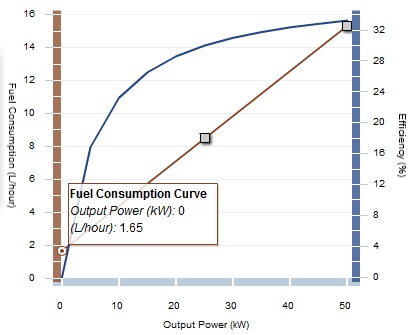
HOMER Grid 1.9

Type: |
Input Variable |
Units: |
fuel units/hr/kWrated |
Symbol: |
F0 |
The generator fuel curve intercept coefficient is the no-load fuel consumption of the generator divided by its rated capacity. If you plot a straight line of fuel consumption versus the power output of the generator, the y-intercept of that line divided by the generator size is equal to the fuel curve intercept coefficient.
For example, if a 50-kW generator consumes 8.48 L/hr at 25 kW output, and 15.3 L/hr at rated output, the slope of the fuel curve is (15.3-8.48)/(50-25) = 0.273 L/hr/kWoutput. So the y-intercept is 8.48 - (0.273*25) = 1.655 L/hr. Dividing by 50 kW (the size of the generator) gives the fuel curve intercept coefficient of 0.033 L/hr/kWrated. This fuel curve is shown below.

The Fuel Curve Calculator helps calculate the fuel curve slope and intercept coefficient.
If the generator is running in a particular time step, HOMER calculates the fuel consumption rate for that time step using the following equation:

where: |
|
|
|
F |
= fuel consumption rate [L/hr] |
|
F0 |
= generator fuel curve intercept coefficient [L/hr/kWrated] |
|
F1 |
= generator fuel curve slope [L/hr/kWoutput] |
|
Ygen |
= rated capacity of the generator [kW] |
Pgen |
= output of the generator in this time step [kW] |
If the generator is not running in a particular time step, the fuel consumption for that time step is zero.
See also
